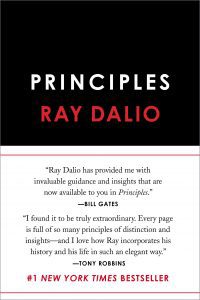
Life is filled with setbacks. How you react to those difficulties will ultimately determine your outcomes. The overarching principle in life as revealed by the author is to think for yourself: It begins with finding out:
(i) what do you want?
(ii) what’s the truth?
(iii) what you should do?
Ray Dalio discusses these 5 broad life principles:
1.Embrace reality & deal with it:
- It is impossible to produce your desired results unless you understand the truth about yourself, others and the world around you.
- Avoid wasting time on views about how things should be otherwise you’ll miss out on learning how they actually are.
- Evolution is the greatest force in the world. It is the only thing that is constant and it drives everything.
2. Use the 5-Step Process to Get What You Want Out of Life:
a) Have Clear Goals :
- Prioritize your goals.
- Goals are not the same as desires. Something you need to achieve is a goal. Desires may stand in the way of your goals.
- Never abandon a goal because you think it’s unachievable.
b) Identify and Don’t Tolerate Problems:
- See unpleasant problems as possible improvements that are yelling at your face.
- Don’t confuse the cause of the problem with the real problem. Get to the root of it.
c) Design a plan:
- View your problem as a set of outcomes generated by a machine.
- There may be many paths to accomplishing your goals, you only have to find one that works for you.
- Write down your plan and measure your progress.
d) Execute to completion:
- Set clear metrics to make sure you’re going according to your plan.
3. Be Radically Open-Minded:
- Ego and your blind spots are your two barriers.
- Consciously teaching your brain to work in a way that doesn’t come normally.
- Don’t bother about looking good, focus only on achieving your goals.
- Learn to appreciate the art of thoughtful disagreement.
4. Understand how people are wired differently:
- To lead and manage people, it is essential to first understand them.
5. Learn How to Make Decisions Effectively:
- The greatest threat to effective decision making is toxic emotions. Decision making is a two-step process; learning, then deciding.
- Everything looks bigger when close. Always retrospect a situation.
- Make your decisions as required value calculations. Think of it as a bet with a chance of reward for being right and a chance of loss for being wrong.
# Key Takeaways:
– Life and work should be guided by principles, which are fundamental truths that can be applied to any situation.
– Principles should be based on values and goals, and should be constantly reevaluated and refined.
– Radical transparency and open communication are essential for creating a successful and efficient organization.
– Embracing mistakes and failures as learning opportunities is crucial for personal and professional growth.
– A meritocratic culture, where individuals are rewarded based on their performance and contribution, leads to a more productive and fair workplace.
# Practical Application:
– Identify your core values and goals, and use them to develop your own set of principles to guide your decisions and actions.
– Foster a culture of open and honest communication within your team or organization, encouraging feedback and constructive criticism.
– Embrace mistakes and failures as learning opportunities, and encourage others to do the same.
– Create a meritocratic system where individuals are rewarded based on their performance and contribution, rather than seniority or favoritism.
# Valuable Insights for Leaders and Managers:
– Chapter 2: “Embrace Reality and Deal with It” emphasizes the importance of facing reality and making decisions based on facts, rather than emotions or biases.
– Chapter 5: “Be Radically Transparent” discusses the benefits of open communication and transparency in creating a successful organization.
– Chapter 7: “Look to the Patterns of the Past” highlights the importance of learning from history and using data to make informed decisions.
– Chapter 9: “Use Tools to Create a Culture of Discipline” offers practical strategies for creating a disciplined and productive workplace.
# Effective Case Studies and Examples:
– The author’s own experience in building and managing Bridgewater Associates, one of the world’s largest hedge funds, serves as a real-life example of the principles outlined in the book.
– The “Dot Collector” tool used at Bridgewater to gather feedback and evaluate employees is a practical example of how technology can be used to create a transparent and meritocratic culture.
– The author’s personal struggles and failures, such as being fired from his first job, serve as powerful examples of how embracing mistakes and failures can lead to personal growth and success.
Leave a Reply